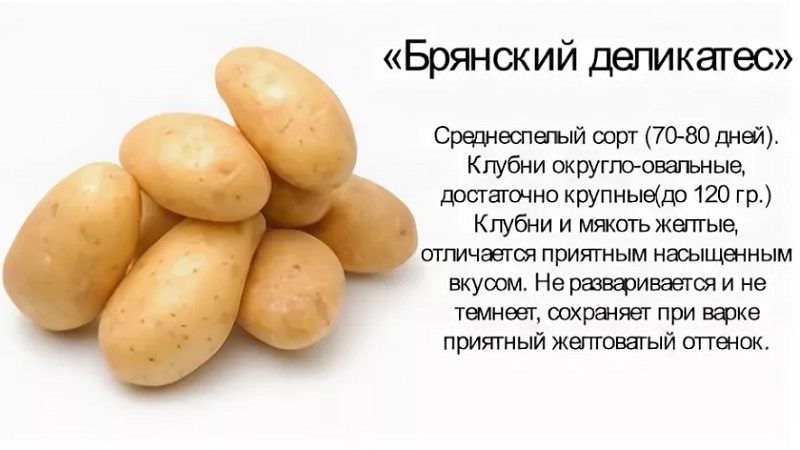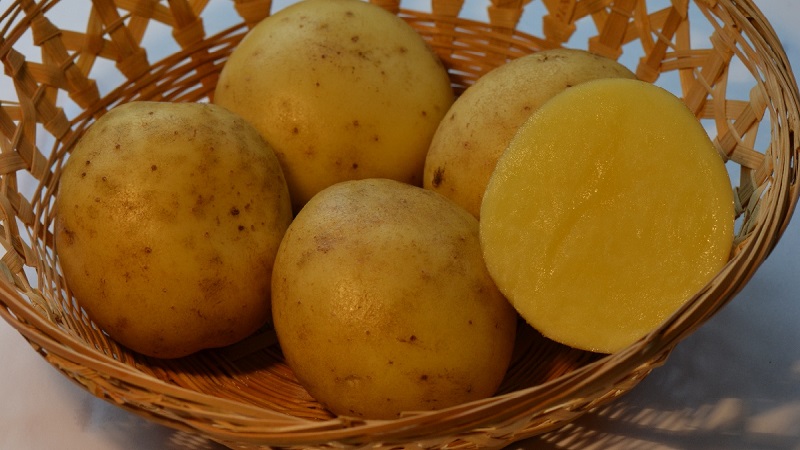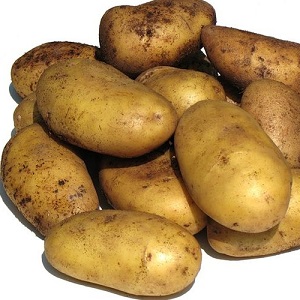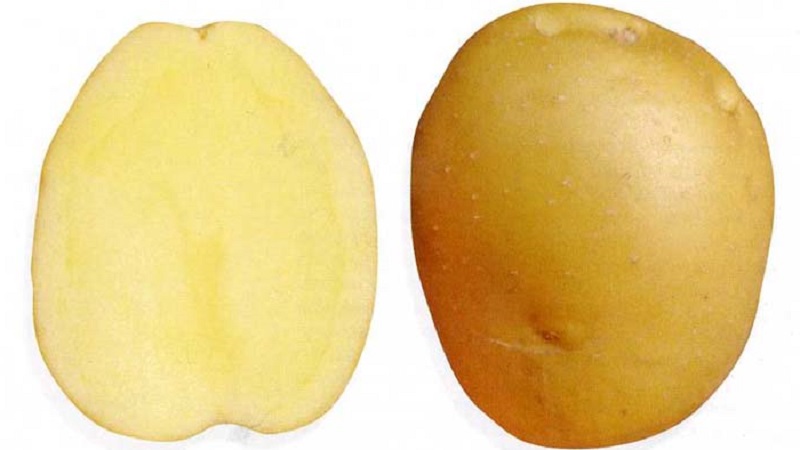Medium early disease-resistant potato variety - Bryansk delicacy
Bryansk delicacy is one of the most promising potato varieties. It gained popularity among gardeners due to its many positive qualities and almost complete absence of shortcomings. In the article we will tell you in detail about the features of the variety and the rules for caring for it.
The content of the article
Description of the variety Bryansk delicacy
This is a table potato variety suitable for growing in private gardens. and on large farms. The tubers are suitable for sale, industrial processing, making chips and French fries.
Origin and development
Potatoes Bryansk delicacy bred by domestic breeders Bryansk Experimental Station, owned by VNII im. A.G. Lorkha. The variety was included in the State Register of Russia in 2002.

Chemical composition, trace elements and vitamins
The pulp of the tubers of the Bryansk delicacy contains 15.6-17.6% starch, and:
- cellulose;
- protein;
- vitamins C, E, PP, H and group B;
- potassium;
- calcium;
- copper;
- iodine;
- magnesium;
- sodium;
- sulfur;
- phosphorus;
- iron;
- selenium;
- chromium;
- manganese;
- beta carotene.
Ripening period and yield
These are medium early ripening potatoes - the duration of the growing season is 75-80 days.
Marketable yield - 162-289 c / ha, maximum (recorded in the Smolensk region) - 299 c / ha.
Disease resistance
 The variety is resistant to most of the diseases and pests inherent in the culture, including:
The variety is resistant to most of the diseases and pests inherent in the culture, including:
- potato cancer;
- striped mosaic;
- curling leaves;
- cyst-forming nematode;
- rhizoctonia;
- scab.
Characteristics of tubers, description of appearance
The plant is a medium-sized sprawling shrub with large dark green leaves. During flowering, small white flowers appear on the bushes, collected in corolla-shaped inflorescences.
Round-oval tubers, weighing 70-125 g, covered with a smooth yellow peel, on the surface of which there are small eyes. The pulp is light yellow in color.
What regions are best suited for and climate requirements
The variety is included in the State Register with a recommendation to cultivation in the Central region of Russia... At the same time, it is successfully grown in other regions and countries where a temperate or subtropical climate prevails.
The main advantages and disadvantages of the variety
Advantages of the Bryansk delicacy:
- the possibility of mechanical planting and harvesting;
- resistance to diseases, pests and mechanical damage;
- high productivity;
- long-term storage;
- good indicators of keeping quality and transportability;
- the lack of a tendency to degeneration in the seed material;
- great taste;
- the possibility of universal use.
Among the cons are the need for frequent hilling and low resistance to late blight.
What is the difference from other varieties
Comparison of the Bryansk delicacy with other varieties of medium early ripening is presented in the table.
| Variety | Ripening period | Productivity, c / ha | Starch content,% | Tuber mass, g | Keeping quality,% |
| Bryansk delicacy | 75-80 days | 162-289 | 15,6-17,6 | 70-125 | 94 |
| Innovator | 75-80 days | 320-330 | Up to 15 | 120-150 | 95 |
| Gala | 75-80 days | Up to 700 | 14-16 | 100-140 | 85-90 |
| Sturdy | 70-80 days | 127-242 | 10-12 | 80-105 | 97 |
Features of planting and growing
This potato variety should only be planted with whole tubers. In the case of planting halves, the yield will significantly decrease and the risk of decay of the planting material will increase even before the emergence of seedlings. Only breeders can cope with the cultivation of the Bryansk delicacy from seeds.

Preparing for landing
Tubers that have mechanical damage are not suitable for planting, signs of disease or decay, as well as too small specimens. The optimal weight of each tuber is about 90 g.
Before planting in the ground, the tubers germinate... To do this, 25-30 days before the expected landing date, they are laid out on the floor in a bright and warm room and regularly moistened with water using a spray bottle.
Important! The sprouts that appear should not outgrow, the maximum permissible length is 1 cm.
Also, pre-planting preparation involves the processing of tubers fungicidal preparations and growth stimulants ("Epin", "Kornevin"). This will speed up germination and protect the potatoes from disease.
The soil is prepared in advance: it is loosened, cleaned of plant residues and 3 buckets of humus, 0.5 liters of wood ash and 40 g of superphosphate are added for each m².
Ground requirements
Potatoes grow well in light, loose and nutritious soil with good moisture and air permeability.
Timing, scheme and landing rules
Planting potatoes spent in the spring, when the soil warms up to + 7 ... + 10 ° C.
 Landing scheme:
Landing scheme:
- Prepare beds with a row spacing of 65 cm in the area.
- Make seating grooves in them every 35 cm.
- Place tubers in holes and sprinkle with earth.
The soil in the aisles is mulchedto slow down the evaporation of moisture.
Growing features
When growing potatoes Bryansk delicacy some rules must be followed:
- you cannot plant a crop in the same place for more than three years in a row;
- the best predecessors of potatoes are legumes, green manure;
- the area after harvesting should be sown with oil radish or phacelia.
The nuances of care
The Bryansk delicacy does not require specific care. To get a plentiful and high-quality harvest, you only need plant potatoes on time, take into account that they need loose and light soil, and comply with standard agrotechnical requirements.
Watering mode
Watered potatoes moderately, focusing on the weather, climatic conditions and soil conditions - it should be slightly damp.
Important! Do not allow the soil to dry out during budding and stopping the growth of tops - a lack of moisture during these periods will negatively affect yield.
In the case of growing the Bryansk delicacy in the regions where it is zoned, watering can be partially or completely (subject to sufficient precipitation) replaced by loosening.
Top dressing
Bryansk delicacy responds well to root and foliar feeding, therefore, they are applied at least three times per season:
- after emergence;
- during budding;
- during the flowering period.
It is better to alternate organic fertilizing with mineral ones. The most suitable organic fertilizer is a mixture of poultry manure with wood ash in a 2: 1 ratio, from mineral it is better to use urea, ammonium nitrate or complex compounds.
Weeding and hilling
Weeding the soil perform as the weed grows, which absorbs moisture and nutrients, which negatively affects the development of tubers and creates favorable conditions for the development of infections.
Spud potatoes 2 times: when the tops are 15 cm high and 12-15 days after that.The procedure is carried out in the evening or early in the morning to minimize the risk of injury to the tubers.
Hilling stimulates the growth of tops and helps protect tubers from frost, therefore, depending on the weather and the growth rate of the crop, the number of procedures can be increased up to four times.

Disease and pest control
Lack of culture-friendly conditions can lead to development late blight... You can minimize the risk of developing the disease by treating the tubers before planting with a fungicide solution - for example, "Maxim", and carrying out preventive spraying of plants during the growing season.
Among pests, the greatest danger for the Bryansk delicacy is colorado beetles, aphids, spider mites and wireworms. They get rid of insects by treating the plantings with special insecticidal preparations ("Commander", "Calypso", "Actellik").
Important! The last treatment should be carried out at least one month before harvest.
Harvesting and storage
It is necessary not only to plant potatoes correctly and provide them with competent care, but also harvest on time and create proper conditions for its storage.
How and when to collect
The first tubers can be dug up 45 days after planting... These potatoes are immediately eaten as they are not suitable for storage. It takes 75-80 days to fully ripen the tubers.
Harvested by hand, digging in the tubers with a shovel, or mechanically.
Storage features and keeping quality of the variety
Fully ripe potatoes are carefully sorted out, discarding damaged copies, and laid out in the open air or under a canopy to dry.
Then the crop is put in boxes and harvested for storage in a dark, well-ventilated room with a temperature of + 2… + 4 ° C. The keeping quality of the variety is 94%.
What can be the difficulties in growing
When growing the Bryansk delicacy, such difficulties may arise:
- development of late blight under improper growing conditions;
- wireworm damage due to violation of the rules of crop rotation and neglect of preventive treatments;
- rotting of seed in the case of planting halves of tubers in the ground.
Tips from experienced gardeners and reviews about the variety Bryansk delicacy
Long-term growers of this potato variety recommend:
- change the potato planting site every 2-3 years - this will help protect the planting from wireworm attacks;
- do not use tubers weighing less than 90 g as seed - the yield will be low;
- store tubers that you plan to use for subsequent planting separately from the main crop.
Here are some reviews of gardeners about potatoes Bryansk delicacy.
Marina, Bryansk region: “When we did not yet have our own plot and had to buy potatoes, we always chose this particular variety - we really like it to taste. Several years ago my family and I moved to a private house and began to grow potatoes ourselves. There was no doubt, they immediately left the choice on the Bryansk delicacy. In addition to the taste, I also like the fact that the harvest is well stored and there is almost no need to water the beds, sometimes there is such a summer that I will water the planting literally 1-2 times for the whole season and that's it. ".
Mikhail, Belgorod: “I grow these potatoes not only for myself, but also for sale - in the photo, the tubers look neat for buyers. For me, the main advantages of the variety are that the tubers have excellent taste, mechanized methods can be used for planting and harvesting, and the bushes need to be processed only from pests, since the Bryansk delicacy is resistant to disease ".
Elena, Tula region: “For 6 years, maybe even more, I have been planting Bryansk delicacy on my site. I do not plan to change the variety, because this one is completely satisfactory - it ripens quickly, the taste is excellent, planting needs minimal care, and the harvest is plentiful and is well stored. ".
Conclusion
Bryansk delicacy is a medium early potato variety that grows well in countries and regions with temperate and subtropical climates. The variety has practically no drawbacks, while it is characterized by resistance to many diseases, pleasant taste, good marketable qualities and unpretentious care.